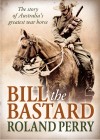Bill the Bastard
Written by: Roland Perry,
Allen & Unwin, 2012,
ISBN 9781743312629, 288pp
Reviewed by: Margaret Palazzo, Hawker College, Canberra
Roland Perry’s Bill the Bastard is a story of Australian servicemen, in particular the men of the Light Horse, and their mounts during the Gallipoli and Palestine campaigns of the First World War. The book focuses on its namesake, the infamous and later adored Waler, Bill ‘the Bastard’, and his trooper Major Michael Shanahan, although this book is ultimately not a celebration of just one courageous soldier and his horse, but of the entire Light Horse. It follows Bill and Shanahan through Gallipoli and Palestine, and into their post-war life, when age and injury finally withdrew them both from service. With the end of the war, Shanahan returned to Australia with his wife Charlotte, with whom he had six children and to whom he was married for 28 years. He continued to ride until the age of 85, and lived on for a further ten years. As for Bill, it is believed that he escaped the knackery or the hard life of Cairo that was the fate of most war horses, and was given, unofficially that is, to an elder of a village near Suvla Bay. Today, a life-sized bronze statue stands in Murrumburrah, depicting Bill carrying Shanahan and four other men to safety during the Battle of Romani.
On the whole, Bill the Bastard is a fairly lighthearted story, considering the often bloody subject matter it deals with, as it is told with humour rather than being a dry and purely factual history. Incorporated into the narrative are occasional stories of individual men and women that, while not strictly relevant, add insight into life as an Australian soldier. Many readers may have some reservations about this mixing of facts and figures with personal stories, but it does provide a realistic idea of what those serving actually experienced. One does begin to wonder, however, how many of these snippets are fictitious, in this non-fiction work. That aside, such additions certainly help to elevate the book, making it a more intricate, personal story, accessible to a wider audience and providing insights that would not be available in more academic-style histories.
Perry’s book is filled with entertaining, genuine and likeable Australian servicemen and women who often strive to make the moral best of a difficult situation, endearing the reader to the soldiers that this book so successfully celebrates. Alongside them, Perry recognises the role of Australian horses, the Walers, which were crucial to the success of the Light Horse. It is touching to read of the relationship between those horsemen who became soldiers and their mounts in war, and pleasing to see a book that acknowledges just how crucial horses were to the war effort. The Australians are painted as the heroes of the campaign, displaying fierce courage, morality and skill as soldiers, as well as being unparalleled horsemen riding unparalleled horses. The book thus serves as an interesting reminder of an age lost, a style of war now forgotten and the mateship that once existed between soldier and horse.
Despite its compelling narrative, Bill the Bastard at times sits awkwardly in an odd middle ground. It is not pure history that provides a detailed and accurate account of the Anzac war efforts. Nor is it light historical fiction that tells the story of men at war. Fortunately, this is a middle ground that will undoubtedly suit many readers well, particularly those looking for a story-like tribute to the Anzacs that also provides accurate names and dates. For serving professional military officers, this book may appear to offer little of relevance. Yet this is only partially true for it also highlights the enduring ideals of bravery, morality and personal triumph that are integral to the Australian military ethic, no matter the age. While not exceptional, this is a fine contribution to the Anzac legend and many will no doubt find Bill the Bastard a worthwhile read.

